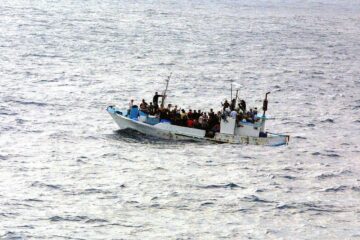![]()
Introduction:
The term ‘International Conflict’ can be defined as the disputes or conflicts between different nation-states and between people and organizations of different states. But in recent times, it can be seen that conflicts amidst groups of a nation where one group is fighting for independence or increased social, political, or economic power. For example, as it can be seen in Sudan, Iraq, and Syria.[1]
After the Second World War and the effects of the knowledge of the Holocaust on humanity, the need for international transparency of issues became an urgent matter. The founders of the United Nation wanted to sway international affairs from unilateralism towards multilateralism and cooperation. Article 1 of the Charter states clearly the main objective of the organization – ‘to maintain international peace and security’ and the ways these goals can be achieved collectively, peacefully, and preventively. For safeguarding international peace and security, Article 1 has also identified two complementary aims, ‘to take effective collective measures for the prevention and removal of threats to the peace, and for the suppression of acts of aggression or other breaches of the peace’ and ‘to bring about by peaceful means, and in conformity with the principles of justice and international law, adjustment or settlement of international disputes or situations which might lead to a breach of the peace.’[2]
We have all read about and reading every day about different international conflicts across the globe. This includes India’s never-ending border conflict with Pakistan as well as Syria’s battle with extremists. To emerge from a world of conflicts and disputes between nations that can engage in war and cost the lives of their innocent citizen like we have seen in the past, we have to come up with ways for resolution.
Current ways to achieve Resolution of International Disputes
The Charter of the United Nations was signed on 25th June, 1945, in San Francisco which laid the pathway for a platform and pact of international conversation and conflict resolving. This Charter laid the groundwork for a mutual understanding of its member and the hope for a transparent global community which can solve its issues through diplomacy and arbitration. Article 2 (3) of the Charter states that ‘all members shall settle their international disputes by peaceful means in such a manner that international peace and security, and justice, are not endangered.’
“‘International’ disputes, however, are not restricted to those between states: also applicable are those disputes involving other entities, including international organizations, ‘de facto regimes, ethnic communities enjoying a particular kind of status under international law, national liberation movements,’ and ‘peoples who are holders of the right of self-determination.”[3] From the above quotation borrowed from the book by Rama Mani and Richard Ponzio on the very same matter, we can understand the intent of this Charter and its importance in resolving international disputes. From Article 2 we get the view of the founders of the UN who wanted to achieve harmony among the governments of nations across the globe for a possibility of cross border injunction by deferring sovereignty for that time being.
Article 33
This article presents various methods to the state that can be used to practically resolve their disputes. Though these methods are seldom used, the UN Legal Office has explained them exhaustively. Article 33 (1) names the different ways of resolving conflicts namely negotiation, inquiry, mediation, conciliation, arbitration, judicial settlement, resort to regional agencies or arrangements, or other peaceful means. It also makes clear that internal conflicts of a country can also be an issue if it affects the means of peace. Also, the importance of resolving issues by peaceful means has been a focus.
Article 33(2) says that the Security Council can call upon the parties when it deems necessary to solve their disputes through the methods as named in Article 33 (1). But this part of the Charter also gives importance to the parties’ willingness to sought for resolution. The UN is keen on the parties to approach the Council which proves to be a hurdle for achieving international dispute resolution. Nevertheless, the States are in no way obliged to exhaust these diplomatic options before approaching the International Court of Justice (ICJ) for legal remedy. Also, their responsibility continues even after they refer the matter to a UN body, or a UN body seizes it.[4]
Methods of Resolving International Disputes through Diplomatic Means
Negotiation
Negotiation is listed in Article 33(1) of the Charter; it paves the very familiar path of achieving a solution through conversation and in some cases compromise by the parties. One important feature of it is the flexibility; negotiations can solve political, legal, or technical issues. The disadvantage of this process is that the party that is the stronger party influences the weaker party for compromise which might seem unjustified and achieved because of the status of the stronger party. Moreover, in this process, the parties themselves steer the conversation and find a way to the solution.
“The UN Legal Office manual provides a step-by-step guide to the different types of negotiation, as well as the phases, methods, and outcomes of each.11 In 1998, the GeneralAssembly adopted resolution 53/101, ‘principles and guidelines for international negotiations,’ which underlines the duty of states to act in good faith in negotiations. Extensive literature addresses negotiation processes, styles, and outcomes.”[5]
Inquiry or Fact-Finding
Two parties to the dispute may themselves form a commission for inquiry for ascertaining the facts of the case/dispute and to determine whether the claimed infraction was committed. These facts are vital to the case and will act as tools for finding resolutions of the dispute and remedies of the damage, if any, caused. Based on these facts, the parties can recommend solutions from their part although none of these will be legally binding and acceptance of these terms will be discretionary to the respective parties. The commission of inquiry may result to be useful by employing other methods like mediation, negotiation, or conciliation as the clarity of the facts is very important in case of any dispute. In 1991, the GeneralAssembly adopted resolution 46/59, which contains detailed rules for fact-finding by organs of the UN, and the UN Legal Office manual explains in detail the process and phases of inquiry.13 Notably, such commissions precede the UN and originated in the Hague Conventions for the Pacific Settlement of International Disputes of 1899 and1907.[6]
Mediation and Good Offices
This is the inclusion of a third party who offer his good offices to the parties engaged in a dispute and to convince them to conclude before the issue further escalates. The primary objective of the third party is to administer the ongoing negotiations and make sure that the communication between the dejected parties don’t fall apart. The third-party could an individual, a state or group of states, or an international or regional organization. The mediator may also proffer proposals to help the parties identify a mutually acceptable outcome. These good offices might be offered by the mediator or might be solicited by one of the parties or both the parties. The fundamental prerequisite of mediation is that both the parties have to recognize the third party as the mediator. Though the term “good offices” is not mentioned in Article 33 but is listed in the UN Legal Office manual. However, the manual mentions that the terms “good offices” and “mediation” could be used as a substitute for each other.
Conciliation
Conciliation is a method that combines fact-finding and mediation. A conciliation commission functions not only to engage negotiations but also to set the facts of the case, to propose solutions mutually accepted by both the parties. The proposals given by the commission are not binding although a party can declare unilaterally that it will adhere to the recommendations of the commission. Several international treaties feature provisions for the systematic referral of disputes for compulsory conciliation. The 1969 Vienna Convention on the Law of Treaties articulated a procedure for the submission by states of requests to the UN Secretary-General for the initiation of conciliation. On 11 December 1995, the General Assembly adopted resolution 50/50, containing the UN Model Rules for the Conciliation of Disputes between States, which substantiates and clarifies conciliation procedures.[7]
Arbitration
The most effective achievement of the 1899 Hague Peace Conference was the establishment of the Permanent Court of Arbitration (PCA), located in the Peace Palace in The Hague. It necessitates the settlement of the dispute in accordance with existing international legal standards. The parties agree to submit disputes to arbitration and from there put their respect and good faith in the outcome which is binding. The PCA, which is always accessible, has competence in all arbitration cases submitted to it by agreement of the parties involved. The PCA provides a list of arbitrators, appointed by state parties to the Hague Convention, from which parties submitting a dispute to arbitration can choose.[8]
International Tribunals
The term ‘international tribunal’ refers to the International Court of Justice. Depending on the definition, there are seventeen and forty such courts and tribunals across the world.[9] Normally, the decisions of these tribunals and courts are binding and cannot be appealed to. The advantage of permanent international tribunals over arbitral courts is that they are better situated than an ad hoc tribunal to become seized of a matter since they already exist.[10]Normally, cases brought to the ICJcover: the interpretation and application of treaties; sovereignty over territory and border disputes; maritime borders and other matters related to the law of the sea; diplomatic protection afforded to foreigners; the use of force; violations of contracts; and principles of customary international law.[11]
Regional Agencies or Arrangements
Article 33 leaves scope for a dispute to be referred to ‘regional agencies or arrangements’ which refers to both regional treaties and organizations. The ChapterVIII is devoted to ‘regional arrangements,’ and their role in dispute settlement is addressed specifically in Article 52. The UN’s dispute settlement manual describes there solution mechanisms and procedures of the Arab League, the Organization of American States, the Organization of African Unity (now reconstituted as the African Union), the council of Europe, the Conference on Security and Co-operation in Europe (now the Organization for Security and Co-operation in Europe, or OSCE), the European Communities (now the European Union), and the Economic Community of West African States (ECOWAS). Also mentioned are the European and American human rights systems, as well as the African Charter on Human and Peoples’ Rights. If an agreement is unsuccessfully brokered by the regional body, the dispute may be referred to the security council.[12]
Why are they not enough?
Even after all the codified measures and methods of conflict resolvent, we still fall short of getting actual results. The UN Charter in itself has laid out different protocols for resolving international conflicts but none of them comes to fruition due to the lack of involvement of the Power Blocs and the parties having the disputes themselves. The lack of engagement of parties who are having a dispute with the UN makes this whole process useless and redundant. The reasons for the lack of implementation and low success rate of resolution of international conflicts are as follows:
1. Ignorance of the Superpowers
The ignorance shown by the Superpowers towards the conflicts of developing and underdeveloped nations makes the issue redundant. Without their interference, these weaker states cannot hope to get help in terms of finance or political diplomacy and the nations themselves shy away from asking for help. The fact that helping these nations will cost the Superpowers also makes them vigilant for not commenting or meddling with these issues.
2. Lack of Involvement of the Parties
The lack of involvement of the parties themselves proves to be an integral reason for failure to initiate negotiations or mediation. Because the disputing parties often don’t want international interference or try to influence the course of action issue within the political borders makes the journey of finding solutions even tougher. The same can be seen in the case of the feud between India and Pakistan. None of the nations want any international interference in their issues directly and want to penalize each other through military operations and engineered economical impediments.
3. Leadership Changes
The frequent change of leadership in the Government of the conflicted nations also makes the process hard. The new leaders of the nation may not adhere to the promises made by the old ones. This leads to confusion and extends the disruption between the nations.
4. Implementation of Agreements
Even if the parties reach an agreement their implementation becomes an issue because no individual or body is supervising the executions of these agreements. The nations out of their own accord may break the terms of the agreement and lead to more conflicts. The other nations can only be spectators if they don’t decide to interfere which happens seldom.
Conclusion
From the methods explained and the hindrances mentioned above, we can come to the conclusion that better ways of resolving international conflicts are not only needed but are integral for maintaining global peace. The two World Wars have given enough cruel memories to the people of not only the nations involved but also to every other individual of the world. We all realize the effects of war on every individual and the grievous consequences it will have in the age of nuclear power. Science and technology has given us a comfortable life but also has given us the way to destroy our whole species.
If an international conflict results in a war and the nuclear warheads resting in the bases of countries prizing them, decides to use them it will lead to the extinction of humanity. Which is why the Superpowers of the world have to be a more active member of the UN and have more interference in international conflict, not only to save their interests but also to prevent any escalation of issues. Without new clear law of execution of resolving international conflicts, Syria will only be one of the first nations to turn to debris due to lack of action by the spectators.
References:
[1] Cate Malek, International Conflict, (May, 2013), https://www.beyondintractability.org/coreknowledge/international-conflict#:~:text=Definition%3A,organizations%20in%20different%20nation%2Dstates.
[2] Rama Mani and Richard Ponzio, Peaceful Settlement of Disputes and Conflict Prevention, 1, 2018
[3] Rama Mani and Richard Ponzio, Peaceful Settlement of Disputes and Conflict Prevention, 3, 2018
[4] Rama Mani and Richard Ponzio, Peaceful Settlement of Disputes and Conflict Prevention, 4, 2018
[5] Rama Mani and Richard Ponzio, Peaceful Settlement of Disputes and Conflict Prevention, 5, 2018
[6] Conventions for the Pacific Settlement of International Disputes of 29 July 1899 (Articles 9–14) and of
18 October 1907 (Articles 9–36).
[7]Cassese, International Law in a Divided World, 211–212.
[8] Rama Mani and Richard Ponzio, Peaceful Settlement of Disputes and Conflict Prevention, 6, 2018
[9] Mikael Madsen, ‘Judicial globalization: the proliferation of international courts’, Research Handbook
on Global Administrative Law, (2016), 13, 282.
[10]Gary Born, International arbitration: cases and materials. (Leiden: Kluwer Law International, 2015.
[11]UN Legal Affairs Office, Handbook, 66.
[12] Rama Mani and Richard Ponzio, Peaceful Settlement of Disputes and Conflict Prevention, 7, 2018



0 Comments